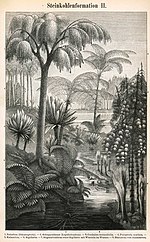Labyrinthodontia (redirect from Labyrinthodont)
of the class Amphibia, modern classification systems recognize that labyrinthodonts are not a formal natural group (clade) exclusive of other tetrapods...
68 KB (7,456 words) - 23:58, 22 August 2024
Acanthostega, a fish-like early labyrinthodont....
78 KB (7,094 words) - 19:34, 7 October 2024
more extreme version found in early tetrapods is known as "labyrinthodont" or "labyrinthodont plicidentine". This type of tooth structure has evolved independently...
104 KB (10,592 words) - 17:52, 1 October 2024
Temnospondyli (section Early finds: Mastodonsaurus and "labyrinthodonts" (early to mid-19th century))
were described at various times as batrachians, stegocephalians and labyrinthodonts, although these names are now rarely used. Animals now grouped in Temnospondyli...
170 KB (17,529 words) - 01:36, 17 September 2024
Warren, A. A.; Hutchinson, M. N.; Hill, Dorothy (1983-09-13). "The last Labyrinthodont? A new brachyopoid (Amphibia, Temnospondyli) from the early Jurassic...
233 KB (25,196 words) - 19:13, 13 October 2024
biphyletic amphibia and used the name Anthracosauria to describe the "labyrinthodont" lineage from which amniotes evolved. In 1970, the German paleontologist...
28 KB (2,971 words) - 19:19, 21 September 2024
Baphetidae is an extinct family of stem-tetrapods. Baphetids were large labyrinthodont predators of the Late Carboniferous period (Namurian through Westphalian)...
6 KB (677 words) - 19:35, 22 March 2024
is enough evidence to indicate that over two thirds of terrestrial labyrinthodont amphibians, sauropsid ("reptile") and therapsid ("proto-mammal") taxa...
375 KB (40,236 words) - 22:22, 13 October 2024
mass of cartilage. A similar arrangement was found in the primitive Labyrinthodonts, but in the evolutionary line that led to reptiles (and hence, also...
43 KB (5,323 words) - 17:50, 29 September 2024
and incisors. The trend towards differentiation is found in some labyrinthodonts and early anapsid reptilians in the form of enlargement of the first...
57 KB (5,746 words) - 21:05, 25 September 2024
inhabiting the coal forests were invertebrates (particularly insects), fish, labyrinthodont amphibians, and early reptiles. Amphibians were widespread, but once...
9 KB (956 words) - 21:14, 4 October 2024
Tadpole remains with telltale external gills are also known from several labyrinthodont groups. Tadpoles are used in a variety of cuisines. Tadpoles of the...
17 KB (2,025 words) - 01:30, 27 August 2024
respiratory mechanism, the primitive breathing system also found in labyrinthodont amphibians Cylindrical centra (the main body of the vertebrae; cylindrical...
14 KB (1,345 words) - 02:41, 27 August 2024
their eggs in water, and are colloquially sometimes referred to as labyrinthodonts or stegocephalians. The term "amphibians" can be ambiguous, however...
8 KB (897 words) - 13:37, 1 May 2024
The gap saw the demise of the Devonian fish-like ichthyostegalian labyrinthodonts and the rise of the more advanced temnospondylian and reptiliomorphan...
114 KB (11,979 words) - 20:55, 8 October 2024
living lungfish. Advanced forms transitional between fish and the early labyrinthodonts, such as Tiktaalik, have been referred to as "fishapods" by their discoverers...
17 KB (724 words) - 18:55, 5 September 2024
; Rich, T.H.; Rich, P. Vickers (January 1991). "An Early Cretaceous labyrinthodont". Alcheringa: An Australasian Journal of Palaeontology. 15 (4): 327–332...
9 KB (932 words) - 13:18, 19 June 2024
their day, the other large carnivores being aquatic or semi aquatic labyrinthodont amphibians. The Limnoscelidae themselves, being close to the ancestry...
3 KB (313 words) - 11:01, 13 April 2024
grouped together as the thecodonts) disappeared, as did most of the large labyrinthodont amphibians, groups of small reptiles, and most synapsids. Some of the...
71 KB (7,717 words) - 19:20, 13 October 2024
longer has recognized scientific status, although the general form "labyrinthodont" is still used as a descriptive term. After a complex nomenclatural...
30 KB (3,288 words) - 13:52, 25 August 2024
extinct, and the most common vertebrate life on land were Lystrosaurus, labyrinthodonts, and Euparkeria along with many other creatures that managed to survive...
41 KB (4,325 words) - 04:33, 24 August 2024
hypsilophodont-like dinosaurs. The South Polar region also was home to the last labyrinthodont amphibian, Koolasuchus. The isolation of Antarctica produced a distinct...
51 KB (5,722 words) - 17:11, 8 July 2024
living lungfish. Advanced forms transitional between fish and the early labyrinthodonts, like Tiktaalik, have been referred to as "fishapods" by their discoverers...
36 KB (2,631 words) - 20:47, 27 September 2024
enamel with a folded pattern, leading to its early classification as a "labyrinthodont" ("maze toothed"). The shape and cross section of Eryops teeth made...
11 KB (1,338 words) - 23:45, 5 September 2024
9 ft) long. The skull was low, with dorsally placed eyes and large labyrinthodont teeth. The posterior margin of the skull formed an operculum covering...
16 KB (1,348 words) - 22:35, 6 October 2024
fenestrae. Post-cranial remains of amniotes can be identified from their Labyrinthodont ancestors by their having at least two pairs of sacral ribs, a sternum...
48 KB (3,794 words) - 19:35, 7 October 2024
with the fusion of the skull roof and the endocranium on the early Labyrinthodonts. In amphibians and reptiles, the vault is rather small and inconspicuous...
3 KB (366 words) - 11:55, 4 April 2024
Ichthyosaurus (Azdyryth) — It first appeared in At the Earth's Core. Labyrinthodont (Sithic) — A giant carnivorous amphibian. It first appeared in At the...
27 KB (3,281 words) - 15:56, 24 August 2024
the Publishing House "Nauka", Moscow) Bentosaurus sushkini, ein neuer Labyrinthodont aus den Permo-Triassischen Ablagerungen des Scharchenga-Flussess, Nord-Duna...
17 KB (1,668 words) - 20:20, 5 August 2024




























